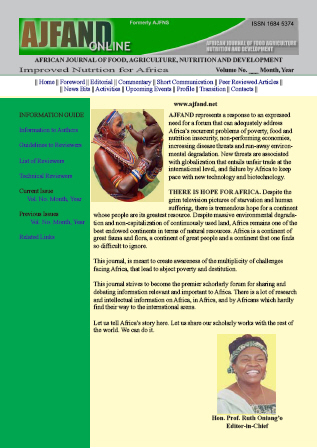
|
African Journal of Food, Agriculture, Nutrition and Development
Rural Outreach Program
ISSN: 1684-5358
EISSN: 1684-5358
Vol. 15, No. 5, 2015, pp. 10406-10427
|
 Bioline Code: nd15058
Bioline Code: nd15058
Full paper language: English
Document type: Review Article
Document available free of charge
|
|
|
African Journal of Food, Agriculture, Nutrition and Development, Vol. 15, No. 5, 2015, pp. 10406-10427
| en |
EFFICACY OF CACTUS PEAR ( Opuntia ficus-indica  ) VARIETIES AS A SOURCE OF FOOD AND FEED IN ENDAMEHONI DISTRICT, NORTHERN ETHIOPIA ) VARIETIES AS A SOURCE OF FOOD AND FEED IN ENDAMEHONI DISTRICT, NORTHERN ETHIOPIA
Gebreegziabher, Z & Tsegay, BA
Abstract
Cactus Pear (Opuntia ficus-indica) serves as a source of food, feed, as well as a means of additional income to the people in northern Ethiopia. The species has different varieties with varied rate of productivity and palatability. This study was conducted to assess the food and feed value of the Cactus Pear varieties in Endamehoni District, northern Ethiopia. It was carried out in three “Tabias” (small administrative sub-districts) and nine sub-Tabias (also known as “Kushets”). These areas were purposively selected as they are well known for their good diversity of Cactus varieties. A total of one hundred and twenty households (n = 120) were randomly selected for interviews using a semi-structured interview. This was supplemented by information obtained through key informants’ interviews and field visits. The local farmers made the identification and characterization of cactus varieties traditionally based on the outstanding phenotypes like fruit characteristics, seed size and content, cladode descriptors and plant height. A total of 13 Cactus varieties were identified and recorded. To assess the food and feed value and to select the best used varieties in the area, preference rankings were made. It was found that not all varieties were equally edible and palatable. The most serious constraints in palatability were associated with fruit taste, fruit size, presence of spines, and hardness of seeds. The ethnobotanical study on palatability was supplemented by chemical analysis on Dry Matter (DM), Ash, Organic Matter (OM) and Crude Protein (CP) content from two-year-old young cladodes of four Cactus varieties (Kille, Wadwada, Magalla and Limo) that are more preferred for food and feed. The analysis of variance (ANOVA) showed significant differences in DM, OM and Ash content at p<0.05 (not at p<0.10). There was no variation in crude protein content amongst the varieties tested. From the results, it is concluded that propagation and use of varieties Kille, Limo, Magalla and Wadwada by farmers of the area is advisable.
Keywords
Characterization; Cladode; Community; ethnobotany; fruit; palatability; preference; propagation; traditional knowledge
|
| |
© Copyright 2015 - African Journal of Food, Agriculture, Nutrition and Development
Alternative site location: http://www.ajfand.net/
|
|
